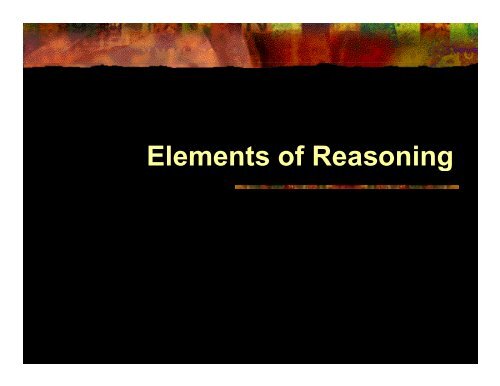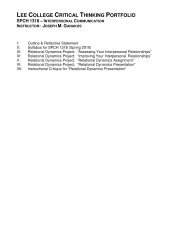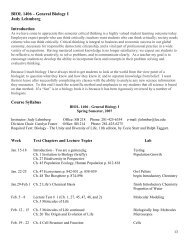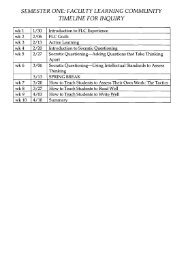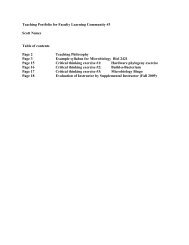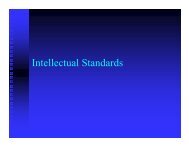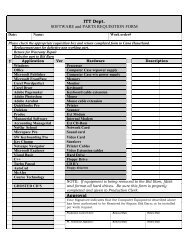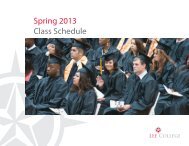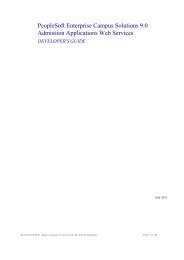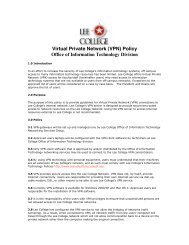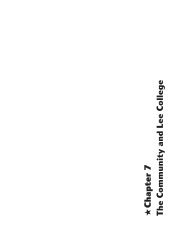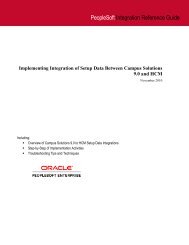Elements of Reasoning
Elements of Reasoning
Elements of Reasoning
You also want an ePaper? Increase the reach of your titles
YUMPU automatically turns print PDFs into web optimized ePapers that Google loves.
<strong>Elements</strong> <strong>of</strong> <strong>Reasoning</strong>
The Three Dimensions<br />
<strong>of</strong> Critical Thinking<br />
Critical<br />
Thinking<br />
Analysis<br />
Evaluation<br />
Improvement<br />
<strong>of</strong> thinking <strong>of</strong> thinking <strong>of</strong> thinking<br />
by focusing on by focusing on by using what<br />
the parts the standards you learned
The Underlying Principles <strong>of</strong> Critical Thinking<br />
Standards<strong>Elements</strong>Traits<br />
The S d d<br />
t clarity precision<br />
must be applied to<br />
accuracy<br />
significance<br />
relevance completeness<br />
logical fairness<br />
breadth depth<br />
The <strong>Elements</strong><br />
purposes inferences<br />
Intellectual Traits<br />
questions concepts<br />
intellectual lhumility<br />
points <strong>of</strong> view implications<br />
information assumptions<br />
intellectual perseverance<br />
intellectual autonomy<br />
intellectual integrity<br />
confidence in reasoning<br />
intellectual courage<br />
intellectual empathy<br />
Fair-mindedness<br />
as we develop
<strong>Elements</strong> <strong>of</strong> <strong>Reasoning</strong><br />
Traits <strong>of</strong><br />
the<br />
Disciplined<br />
Mind<br />
<strong>Reasoning</strong><br />
The process <strong>of</strong><br />
drawing conclusions or<br />
figuring something out<br />
Standards<br />
for<br />
<strong>Reasoning</strong><br />
<strong>Reasoning</strong>: three<br />
aspects
Circle –<br />
Dots
What is involved in analyzing reasoning?<br />
(Story, argument, point <strong>of</strong> view, subject)<br />
In other words, what elements must you<br />
, y<br />
account for in order for the analysis to be<br />
substantive?
Whenever we think<br />
in attempting<br />
to answer a<br />
question.<br />
based on<br />
concepts and<br />
theories<br />
to make<br />
inferences and<br />
judgments<br />
We use<br />
data, facts,<br />
and<br />
experiences<br />
We think<br />
for a<br />
purpose<br />
leading to<br />
implications<br />
and conse -<br />
quences.<br />
within a<br />
point <strong>of</strong> view<br />
based on<br />
assumptions
A CRITICAL THINKER<br />
Considers the<br />
<strong>Elements</strong> <strong>of</strong> Thought<br />
Points <strong>of</strong> View<br />
Frame <strong>of</strong> Reference<br />
Perspective<br />
Orientation<br />
Purpose <strong>of</strong> the<br />
Thinking<br />
Goal, objective<br />
Implications &<br />
Consequences<br />
Assumptions<br />
Presuppositions,<br />
taking for granted<br />
<strong>Elements</strong><br />
<strong>of</strong><br />
Thought<br />
Questions at<br />
Issue<br />
Problem<br />
Information<br />
Data, observations,<br />
facts, experiences<br />
Concepts<br />
Theories, laws,<br />
models, definitions,<br />
principles<br />
Interpretation<br />
& Inference<br />
Conclusions,<br />
solutions<br />
<strong>Elements</strong> wheel
We must<br />
routinely<br />
Take our<br />
thinking<br />
We must routinely take our thinking apart<br />
apart
<strong>Elements</strong> <strong>of</strong> <strong>Reasoning</strong><br />
• Pairs. Analytic Thinking Guide.<br />
Persons A, B. Person A will study pp.<br />
4-5. Person B, pp. 6-7.<br />
• Study for approx. 5 minutes in order to<br />
teach your pages to one another.<br />
• When teaching, notes can be used to<br />
teach, but not the guide.
Teaching <strong>Elements</strong><br />
• Join groups together to form groups <strong>of</strong> 4.<br />
Persons A, B, C, D. The goal in this<br />
activity is for you to learn the elements <strong>of</strong><br />
reasoning more deeply. py You will study, in<br />
order to teach, the following pages<br />
(Analytic y Guide): )
• Person A will focus on Purpose, (pp. 14, 42),<br />
and Assumptions (pp. 18, 46)<br />
• Person B will focus on Question, (pp. 15, 43),<br />
and Concepts, (pp. 19, 47)<br />
• Person C will focus on Information (pp. 16, 44),<br />
and Point <strong>of</strong> View, (pp. 20, 48)<br />
• Person D will focus on Inference, (pp. 17, 45),<br />
and Implications, (pp. 21, 49)
• You will have 12 minutes to study all<br />
pages in order to teach your concepts to<br />
your group. After six minutes, I will signal<br />
you to move to your second concept in<br />
preparing, if you haven’t already.
Check for Understanding<br />
In the next phase <strong>of</strong> this activity, before you<br />
begin to teach, you will join together th with the<br />
people who studied the same concepts you<br />
studied. This is an important part <strong>of</strong> the study<br />
process. It will help correct for mistakes in<br />
understanding as well as deepen your<br />
understanding <strong>of</strong> the concepts you will be<br />
teaching. Persons A join together in one group,<br />
Persons B, Persons C, and Persons D in other<br />
groups. If you have more than 5 people per<br />
group, split into additional groups, so you may<br />
have several “Person A” groups, etc.
Teach to Your Group<br />
• Go back to your original i groups <strong>of</strong> 4 for the<br />
teaching process.<br />
• Each person will have 3 minutes to teach each <strong>of</strong><br />
your elements to their group.<br />
• If you run out <strong>of</strong> things to say in your 3 minutes, see if you<br />
can answer any questions from your group. Person A will<br />
begin with Purpose. At the end <strong>of</strong> 3 minutes, you will hear<br />
the tone. Stop immediately, even if in mid- sentence, and<br />
Person B then teaches Question for three minutes. Keep<br />
going around the table in this way moving through all <strong>of</strong> the<br />
eight elements in this order. Move to the next person, and<br />
therefore the next concept every time you hear the tone.
Teach in this order:<br />
• Purpose<br />
• Questions<br />
• Information<br />
• Inference<br />
• Assumptions<br />
• Concepts<br />
• Point <strong>of</strong> View<br />
• Implications
Conscious and Unconscious thinking<br />
Unconscious Level <strong>of</strong> Thinking
Information Inference Assumption<br />
(situation)<br />
1. You see a man with a He has been hit by People e who have black<br />
black eye<br />
someone<br />
eyes have been hit<br />
2. A police <strong>of</strong>ficer He is trying to catch Anytime a police <strong>of</strong>ficer<br />
trails your car for<br />
several blocks<br />
me breaking the<br />
law<br />
trails you he is trying to<br />
catch you breaking the law<br />
3. During class, a<br />
student asks “is this<br />
going to be on the<br />
test?”<br />
4. You see a child crying<br />
next to her mother in a<br />
grocery store<br />
5. You see a man<br />
in tattered clothes sitting on<br />
a curb with a paper bag in<br />
his hand<br />
This student is not<br />
interested<br />
in learning the<br />
subject<br />
The mother has<br />
hurt the child<br />
He must be a<br />
bum<br />
Students who ask questions<br />
like: “Is this going to be on<br />
the test?” are not interested<br />
in learning the subject<br />
Whenever a child is crying<br />
next to her mother she has<br />
been hurt by her mother<br />
All men in tattered clothes<br />
sitting on curbs with paper<br />
bags in their hands are<br />
bums
Information<br />
1. Your teenage son is late<br />
coming home from a late<br />
night date<br />
2. Your spouse is late<br />
coming home from<br />
work<br />
3. You meet a beautiful<br />
woman with blond hair<br />
4. You get an ‘A’ on a<br />
history test.<br />
Inference<br />
Assumption<br />
5. Your spouse is talking<br />
to a member <strong>of</strong> fthe<br />
opposite sex at a late<br />
night party
A critical thinker considers the elements <strong>of</strong> reasoning
<strong>Elements</strong> blank<br />
wheel
Eight Questions Students Can Routinely<br />
Ask When They Understand<br />
the <strong>Elements</strong> <strong>of</strong> <strong>Reasoning</strong><br />
1. What is the main purpose <strong>of</strong> the reasoning?<br />
2. What are the key issues, problems, and questions<br />
being addressed?<br />
3. What is the most important information being used?<br />
4. What main inferences are embedded in the<br />
reasoning?<br />
5. What are the key concepts guiding the reasoning?<br />
6. What assumptions are being used?<br />
7. What are the positive and negative implications? ?<br />
8. What point <strong>of</strong> view is/should be represented?
Eight Questions Students Can Ask to Figure out<br />
the Logic <strong>of</strong> a Character in a Story<br />
1. What is the main purpose <strong>of</strong> the character?<br />
2. What are the key issues and problems facing the character?<br />
3. What is the most significant information the character uses in<br />
his or her reasoning?<br />
4. What main inferences or judgments are made by the<br />
character?<br />
5. What key concepts guide the character’s reasoning?<br />
6. What main assumptions guide the behavior <strong>of</strong> the character?<br />
7. What are the most important implications <strong>of</strong> the character’s<br />
thinking and behavior?<br />
8. What is the main point <strong>of</strong> view <strong>of</strong> the character? Does that<br />
point <strong>of</strong> view change during the story? If so, how?
Eight Questions Students Can Ask to<br />
Figure out the Logic <strong>of</strong> a Subject or<br />
Discipline:<br />
1. What is the main purpose <strong>of</strong> fthe subject?<br />
2. What are the key issues, problems, and questions<br />
addressed within the subject?<br />
3. What kinds <strong>of</strong> information are pursued within the<br />
discipline?<br />
4. What types <strong>of</strong> inferences or judgments are made?<br />
5. What key concepts inform the discipline?<br />
6. What key assumptions underlie the discipline?<br />
7. What are some important implications <strong>of</strong> studying the<br />
discipline?<br />
8. What points <strong>of</strong> view are fostered within the discipline?
Questions Targeting the <strong>Elements</strong> <strong>of</strong> Thought<br />
in a writing a paper<br />
Purpose: What am I trying to accomplish? What is my central aim or<br />
goal?<br />
Information: What information am I using in coming to that conclusion?<br />
What experience have I had to support this claim? What<br />
information do I need to settle the question?<br />
Inferences/Conclusions: How did I reach this conclusion? Is there<br />
another way to interpret the information?<br />
Concepts: What is the main idea here? Could I explain this idea?<br />
Assumptions: What am I taking for granted? What assumption has led<br />
me to that conclusion?<br />
Implications/Consequences: If someone accepted my position, what<br />
would implications? What am I implying?<br />
Points <strong>of</strong> View: From what point <strong>of</strong> view am I looking at this issue? Is<br />
there another point <strong>of</strong> view I should consider?<br />
Questions: What question am I raising? What question am I<br />
addressing?
The Underlying Principles <strong>of</strong> Critical Thinking<br />
Standards<strong>Elements</strong>Traits<br />
The S d d<br />
t clarity precision<br />
must be applied to<br />
accuracy<br />
significance<br />
relevance completeness<br />
logical fairness<br />
breadth depth<br />
The <strong>Elements</strong><br />
purposes inferences<br />
Intellectual Traits<br />
questions concepts<br />
intellectual lhumility<br />
points <strong>of</strong> view implications<br />
information assumptions<br />
intellectual perseverance<br />
intellectual autonomy<br />
intellectual integrity<br />
confidence in reasoning<br />
intellectual courage<br />
intellectual empathy<br />
Fair-mindedness<br />
as we develop
Activity One:<br />
Taking Initial Ownership <strong>of</strong> the <strong>Elements</strong><br />
pp. 4-5intheMiniature Guide to Critical Thinking.<br />
In pairs, one person will explain the odd<br />
numbered elements, the other, the even<br />
numbered. Read the first sentence to your<br />
partner, then explain the element in your own<br />
words.<br />
Then read aloud the criteria listed for assessing<br />
reasoning using the elements. Then move to<br />
the next element. Notice which elements you<br />
are the most comfortable in explaining and<br />
which you find more difficult.
<strong>Elements</strong> <strong>of</strong> <strong>Reasoning</strong>:<br />
Constructing Initial Understandings<br />
• Work in pairs. Person A. Person B.<br />
• Use Analytic Thinking Guide.<br />
• Person A will study p. 10 to teach the<br />
content to your partner.<br />
• Person B will study p. 11 to teach it to your<br />
partner.<br />
• Take notes. Use notes to teach.
Working in pairs<br />
• Silently read the following pages:<br />
18, 19, 20, 31, 32, 33<br />
• Then discuss your understanding <strong>of</strong> these<br />
pages and their significance to instruction.
Take your understanding <strong>of</strong> the elements <strong>of</strong><br />
reasoning to the next level<br />
• Work in pairs.<br />
• Each person draws two circles<br />
• Using your best thinking, fill in your two circles<br />
with as much detail as possible:<br />
a. One circle includes the main points about the<br />
elements.<br />
b. One circle has questions you can ask when you<br />
understand the elements.<br />
c. Then add some intellectual standards to the first<br />
circle.
<strong>Elements</strong> t wheel <strong>of</strong> <strong>Reasoning</strong> with directions<br />
Working in pairs, draw the elements <strong>of</strong><br />
reasoning circle<br />
Define each<br />
Element. Then fill<br />
In the circle<br />
with as much<br />
detail as<br />
you can.
Add Add standards the Standards<br />
d to the d wheel<br />
Now add the intellectual<br />
standards to your wheel.<br />
Which ones relate to<br />
which elements? Add to<br />
the outside <strong>of</strong> your circle.
<strong>Elements</strong> <strong>of</strong> wheel – add<br />
<strong>Elements</strong> <strong>of</strong> <strong>Reasoning</strong><br />
questions<br />
Questions<br />
Draw another circle, and<br />
fill it in with questions you<br />
can ask when you<br />
understand the<br />
elements<br />
<strong>of</strong> reasoning and<br />
are using<br />
them explicitly<br />
in your thinking.
The Logic <strong>of</strong> an Experiment<br />
(Attach a detailed description <strong>of</strong> the experiment or<br />
laboratory procedure.)<br />
The main goal <strong>of</strong> the experiment is…<br />
The hypothesis(es) we seek to test t in this experiment<br />
is(are)…<br />
The key question the experiment seeks to answer is…<br />
The controls involved in this experiment are…<br />
The key concept(s) or theory(ies) behind the experiment<br />
is(are)…<br />
The experiment is based on the following assumptions…<br />
The data that will be collected in the experiment are…<br />
The potential implications <strong>of</strong> the experiment are…<br />
The point <strong>of</strong> view behind the experiment is…
The Logic <strong>of</strong> Ecology<br />
Goals <strong>of</strong> Ecologists: Ecologists seek to understand plants and<br />
animals as they exist in nature, with emphasis on their<br />
interrelationships, interdependence, and interactions with the<br />
environment. They work to understand all the influences that<br />
combine to produce and modify an animal or given plant, and thus<br />
to account for its existence and peculiarities within its habitat.<br />
Questions that Ecologists Ask: How do plants and animals interact?<br />
How do animals interact with each other? How do plants and<br />
animals depend on one another? How do the varying ecosystems<br />
function within themselves? How do they interact with other<br />
ecosystems? How are plants and animals affected by environmental<br />
influences? How do animals and plants grow, develop, die, and<br />
replace themselves? How do plants and animals create balances<br />
between each other? What happens when plants and animals<br />
become unbalanced?
Information that Ecologists Use: The primary information<br />
used dby ecologists is gained dthrough hobserving plants<br />
and animals themselves, their interactions, and how they<br />
live within their environments. Ecologists note how<br />
animals and plants are born, how they reproduce, how<br />
they die, how they evolve, and how they are affected by<br />
environmental changes. They also use information from<br />
other disciplines i including chemistry, meteorology and<br />
geology.<br />
Judgments that Ecologists Make: Ecologists make<br />
judgments about how ecosystems naturally function,<br />
about how animals and plants within them function,<br />
about why they function as they do. They make<br />
judgments about how ecosystems become out <strong>of</strong><br />
balance and what can be done to bring them back into<br />
balance. They make judg-ments about how natural<br />
communities should be grouped and classified.
Concepts that Guide Ecologists’ Thinking: One <strong>of</strong> the most<br />
fundamental concepts in ecology is ecosystem, defined as a<br />
group <strong>of</strong> living things that are dependent on one another and<br />
living in a particular habitat. Ecologists study how differing<br />
ecosystems function. Another key concept in ecology is<br />
ecological succession, the natural pattern <strong>of</strong> change occurring<br />
within every ecosystem when natural processes are<br />
undisturbed. This pattern includes the birth, development,<br />
death, and then replacement <strong>of</strong> natural communities.<br />
Ecologists have grouped communities into larger units called<br />
biomes, regions throughout the world classified according to<br />
physical features, including temperature, rainfall and type <strong>of</strong><br />
vegetation. Another fundamental concept in ecology is<br />
balance <strong>of</strong> nature, the natural process <strong>of</strong> birth, reproduction,<br />
eating and being eaten, which keeps animal/plant<br />
communities fairly stable. Other key concepts include<br />
imbalances, energy, nutrients, population growth, diversity,<br />
habitat, competition, predation, parasitism, adaptation,<br />
coevolution, ol succession and climax communities and<br />
conservation.
Key Assumptions that Ecologists Make: Patterns exist<br />
within animal/plant communities; these communities<br />
should be studied and classified; animals and plants<br />
<strong>of</strong>ten depend on one another and modify one another;<br />
and balances must be maintained within ecosystems.<br />
Implications <strong>of</strong> Ecology: The study <strong>of</strong> ecology leads to<br />
numerous implications for life on Earth. By studying<br />
balance <strong>of</strong> nature, for example, we can see when nature<br />
is out <strong>of</strong> balance, as in the current population explosion.<br />
We can see how pesticides, designed to kill pests on<br />
farm crops, also lead to the harm <strong>of</strong> mammals and birds,<br />
either directly or indirectly through food webs. We can<br />
also learn how over-farming causes erosion and<br />
depletion <strong>of</strong> soil nutrients.<br />
Point <strong>of</strong> View <strong>of</strong> Ecologists: Ecologists look at plants and<br />
animals and see them functioning in relationship with<br />
one another within their habitats, and needing to be in<br />
balance for the earth to be healthy and sustainable.
Activity Two:<br />
Beginning to Figure Out the Logic <strong>of</strong> Education<br />
Using your beginning understanding <strong>of</strong> the<br />
elements <strong>of</strong> reasoning, take turns<br />
completing these statements.<br />
The purpose <strong>of</strong> education is…<br />
The main problem(s) we face in educating<br />
our students is/are…<br />
If we truly educate students, some <strong>of</strong> the<br />
important implications are…
Activity Three:<br />
Beginning g to Figure Out the Logic <strong>of</strong> a Subject or<br />
Discipline<br />
Using your beginning understanding <strong>of</strong> the<br />
elements <strong>of</strong> reasoning, take turns<br />
completing these statements.<br />
The purpose <strong>of</strong> the discipline is…<br />
Some <strong>of</strong> the main questions pursued within<br />
the discipline are…<br />
Some <strong>of</strong> the important implications <strong>of</strong><br />
studying the discipline are…
SEEI Strategy<br />
• (State)To me this means…<br />
• (Elaborate) In other words…<br />
• (Give example from real life) To<br />
exemplify…<br />
• (Give an analogy to improve<br />
understanding)To illustrate…
Process<br />
• What important insights did you gain<br />
through h doing these activities iti –<br />
insights about the elements <strong>of</strong><br />
reasoning?<br />
• How might you better foster use and<br />
understanding <strong>of</strong> the elements <strong>of</strong><br />
reasoning in your classes?<br />
Refer to pp. 22-23, 24-27, 28, 29, 30
State, elaborate, exemplify<br />
<strong>Elements</strong> <strong>of</strong> reasoning<br />
intellectual standards<br />
Purpose<br />
clarity<br />
Question<br />
accuracy<br />
Information<br />
precision<br />
Inference<br />
relevance<br />
Assumption<br />
logicalness<br />
Concepts<br />
depth<br />
Implications<br />
breadth<br />
Point <strong>of</strong> view<br />
significance<br />
fairness<br />
Egocentricity, dominating ego, submissive ego<br />
Sociocentricity<br />
Intellectual virtues
Gerald’s diagram
The elements are the result <strong>of</strong> the analysis<br />
<strong>of</strong> the obvious.
Circle –<br />
Dots
HMS Daedalus Incident<br />
• The second foreign vessel to drop anchor<br />
in Waimea was the HMS Daedalus, a<br />
shore ship <strong>of</strong> Captain George Vancouver.<br />
It was on May 11, 1792, that the Daedalus<br />
sent out a party <strong>of</strong> eight men to locate a<br />
supply <strong>of</strong> fresh water in the valley. Only<br />
five men returned to the ship.
An account from a native present said that a<br />
dispute arose at the watering place<br />
between the Hawaiians and the men <strong>of</strong><br />
the Daedalus. The reason for the attach is<br />
not clear, but a Portuguese seaman was<br />
killed and two <strong>of</strong>ficers, Lieutenant Hergist,<br />
and astronomer, Mr. Gooch, were carried<br />
<strong>of</strong>f and killed.
Six Hawaiians were later punished with<br />
death as a result <strong>of</strong> their attack on these<br />
British seamen.<br />
This tragedy resulted from a<br />
misunderstanding between two cultures.


